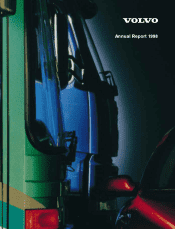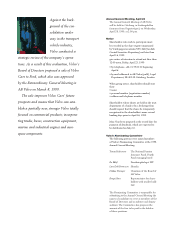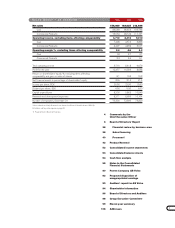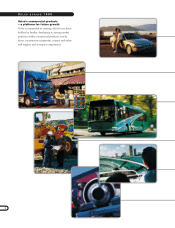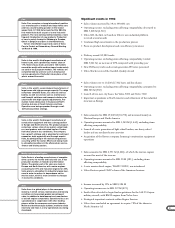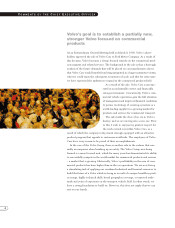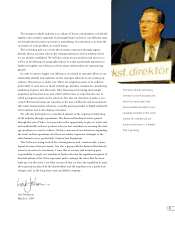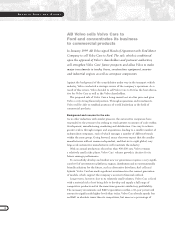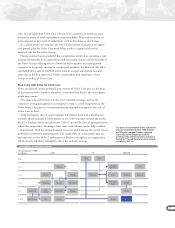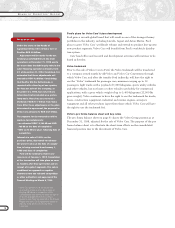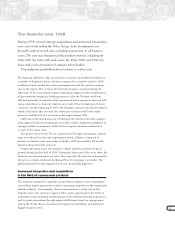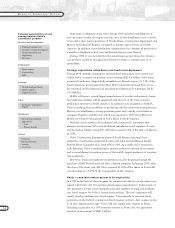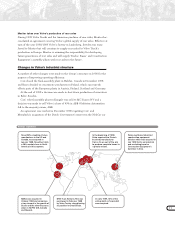Volvo 1998 Annual Report Download - page 5
Download and view the complete annual report
Please find page 5 of the 1998 Volvo annual report below. You can navigate through the pages in the report by either clicking on the pages listed below, or by using the keyword search tool below to find specific information within the annual report.
• Sales volume increased by 3% to 399,680 cars
• Operating income, excluding items affecting comparability, decreased to
SEK 3,808 M (4,510)
• Volvo S80, the first car based on Volvo’s new industrial platform
received several awards
• Continued high investments in the production process
• Focus on product development and cost-efficiency measures
3
Volvo Aero is a global player in the aerospace
industry, in which service, maintenance and leasing
constitute an increasingly greater percentage of
sales, in addition to development and manufacture
of aircraft engine components. Operations focus on
specialization in cooperation with other leading
players within the aerospace and space industry.
Marine and land-based gas turbines, mainly to create
electricity and heat, is a new operational area being
developed.
Volvo Penta is a leading manufacturer of complete
drive systems for marine and industrial use. It has
production facilities in Sweden and the United
States. The greater part of its sales are made in
Europe and North America, with marine engines
accounting for 70% and industrial engines for 30%.
Volvo plans to strengthen its industrial engine busi-
ness in order to reduce its dependence on the
marine sector, which is more sensitive to changes
in economic conditions.
Volvo is the world’s third-largest manufacturer of
construction equipment and has a strong position
in Europe and North America. The product program
comprises various sizes of excavators, wheel load-
ers, road graders and articulated haulers. Produc-
tion takes place in four continents. The company
has a growth strategy and is planning for continued
expansion, both organically and through acquisi-
tions, by participating in the restructuring process
occurring within the sector. Efforts are being made
to strengthen positions in the aftermarket, service,
finance and leasing sectors.
Volvo is the world’s second-largest manufacturer of
large buses with high passenger capacity. The range
comprises complete buses, bus chassis and bus
bodies, as well as services such as maintenance
and financial solutions and transport solutions for
urban traffic with high capacity requirements. Pro-
duction mainly takes place in Europe and North
America, but also in South America and Asia.
Operations are being expanded through a well-
defined acquisition strategy.
Volvo is the world’s third-largest manufacturer of
heavy trucks, with a preliminary market share of
11%. Volvo’s heavy trucks are sold in 120 markets
around the world, while medium-heavy trucks mainly
are sold in the European markets. The vehicles are
complemented by services such as leasing and
service agreements. Production takes place at ten
plants around the world.
Volvo Cars occupies a strong international position
as a manufacturer of medium and large family cars
and has a world-leading position in the station
wagon field. In 1998, Volvo launched the S80, the
first model to be built as part of a new industrial
platform. The new working method enables a more
frequent introduction of new products. Production
of cars is mainly located in Göteborg in Sweden,
Ghent in Belgium and Born in the Netherlands.
Volvo’s shareholders approved a sale of Volvo
Cars to Ford at an Extraordinary General Meeting
on March 8, 1999.
Trucks
Cars
Buses
Construction Equipment
Marine and Industrial Engines
Aero
• Delivery record: 83,280 trucks
• Operating income, excluding items affecting comparability, totaled
SEK 3,061 M, an increase of 69% compared with preceding year
• New FM heavy trucks and second-generation FH series presented
• Volvo Trucks received the Swedish Quality Award
• Sales volume rose to 10,200 (8,730) buses and bus chassis
• Operating income, excluding items affecting comparability, amounted to
SEK 385 M (550)
• Launch of two new city buses, the Volvo 5000 and Volvo 7000
• Important acquisitions in North America and refinement of the industrial
structure in Europe
• Sales amounted to SEK 19,469 M (16,758) and increased mainly in
Western Europe and North America
• Operating income amounted to SEK 1,549 M (1,444), excluding items
affecting comparability
• Launch of a new generation of light wheel loaders, one heavy wheel
loader and one medium-heavy excavator
• Acquisition of the Korean company Samsung’s construction equipment
operations
• Sales amounted to SEK 4,931 M (4,466), of which the marine engines
account for most of the increase
• Operating income amounted to SEK 95 M (181), excluding items
affecting comparability
• A new marine diesel engine, TAMD 74 EDC, was introduced
• Volvo Penta acquired OMC’s share of the American business
• Income increased by 15% to SEK 8,584 M
• Operating income rose to SEK 527 M (472)
• South Africa decided to begin final negotiations for the JAS 39 Gripen
military aircraft, with RM12-engines from Volvo Aero
• Strategical important contracts within Engine Services
• Volvo Aero concluded an agreement to acquire 78% of the shares in
Norsk Jetmotor AS
Significant events in 1998

